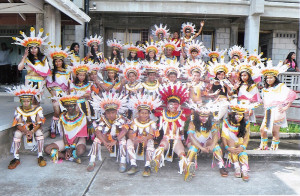History

The Amerindian Scholarship Programme was introduced in 1962. The first six (6) students were those who had written the Common Entrance Examination and performed creditably. They were awarded places at Secondary Schools in the capital city, Georgetown. Hence scholarships were offered annually to the outstanding performers.
The need for the older students to be trained in Technical, Vocational and Tertiary skills was evident, thus, the number of scholarships awarded annually was increased in 1966. Scholarships were offered to the Government Technical Institute, the Carnegie School of Home Economics and the Guyana School of Agriculture.
Scholarships were offered to Hinterland students attending the University of Guyana in1986. Since the Public Service Ministry (P.S.M.) offers scholarships to students desirous of attending University, a decision was taken in 2000 not to sponsor these students but to have them apply to P.S.M.
In 1976 the Amerindian Scholarship Programme was renamed the Hinterland Scholarship Programme to cater for the children of mixed parentage or non Amerindians living and working in the Interior.

Presently, approximately eighty scholarships are offered annually and a number of students who are experiencing financial difficulties, once verified, are offered assistance. Approximately two hundred and ninety-five (295) students are on the Programme annually and another twenty (20) receive assistance. This amount includes students attending institutions in Guyana’s ten (10) administrative regions.
Various Government Ministries were responsible for the Amerindian Scholarship Programme. The Ministry of Local Government had the longest responsibility, until the Ministry of Amerindian Affairs was introduced and it was tasked with the responsibility of the Programme.
Eligibility

Originally, students who wrote the Common Entrance Examination presently called the Secondary Schools Examination (SSEE) and obtained 470 – 480 marks or 83.3 % were awarded a Regional Scholarship, that is, to attend Secondary school in their respective Regions if there is a school or may opt to attend in a neighbouring Region. Those who gain more than 480 marks or 85.1% qualify to attend Secondary schools in Georgetown.
With the introduction of the National Grade Six Examination and continuous assessment were 5% and 10 % of the total marks of the Levels 2 and 4 exams are accumulated and added to the Level 6 examination which is 85 % of the marks. Hence, the student will need to obtain 83% and 85% of the total marks to earn a National Scholarship respectively.
The older students between the ages of 15 – 18 years, especially those, who due to the unavailability of Secondary Schools in some regions in the past and did not have access to a “higher secondary education,” must apply to the Ministry of Amerindian Affairs for a scholarship to attend a Vocational institution, such as Guyana Industrial Training Centre, Carnegie School of Home Economics and Craft Production and Design Division or the Government Technical Institute to undergo studies for a craft certificate.

To pursue certificates and diploma course at the Guyana School of Agriculture, the Burrowes School of Art and the Government Technical Institute, applicants must have at least three or more Caribbean Secondary Education Certificate (CSEC) subjects. All applications should be accompanied by recommendations from the Captain, Head Teacher, Community Development Officer or any other person of good standing in the Community.
Hinterland Scholarship Student’s Dormitory
On September 03, 2010 the Dormitory was commissioned by his excellence President Bharat Jadgeo. Students took up residence on January 2, 2011.
Students who receive National Scholarships and travel to Georgetown to attend school are accommodated at the Dormitory; if they are not awarded the President’s College.
However, some parents asked that students remain with them or relatives, in Georgetown. Students at the Dormitory are cared for by House Parents, a Nurse, Cooks, Cleaners and a laundry.
Transportation takes them to and from school, to extra curricula act ivies among other events. They receive the same allowances as the others.

NUMBER OF STUDENTS BY REGIONS JOINING THE SCHOLARSHIP PROGRAMME 2020- 2025
| YEAR | ||||||
| REGIONS | 2020 | 2021 | 2022 | 2023 | 2024 | 2025 |
| 1 | 28 | 0 | 24 | |||
| 2 | 28 | 2 | 20 | |||
| 3 | 1 | 1 | 3 | |||
| 4 | 15 | 2 | 15 | |||
| 5 | 0 | 2 | 2 | |||
| 6 | 5 | 0 | 7 | |||
| 7 | 25 | 2 | 18 | |||
| 8 | 42 | 2 | 24 | |||
| 9 | 34 | 1 | 35 | |||
| 10 | 15 | 0 | 19 | |||
| GRAND TOTAL | 193 | 12 | 167 | |||
CSEC RESULTS 2020 – 2025
|
YEAR
|
NO. OF STUDENTS
|
NO. OF SUBJECTS
|
GRADES 1-3
|
% PASS
|
| 2020 | 79 | 810 | 735 | 91 |
| 2021 | 61 | 504 | 441 | 88 |
| 2022 | 61 | 563 | 495 | 88 |
| 2023 | 86 | 823 | 682 | 83 |
| 2024 | ||||
| 2025 |

